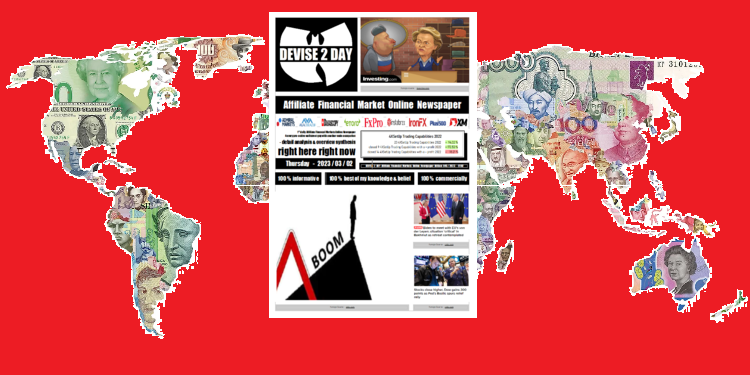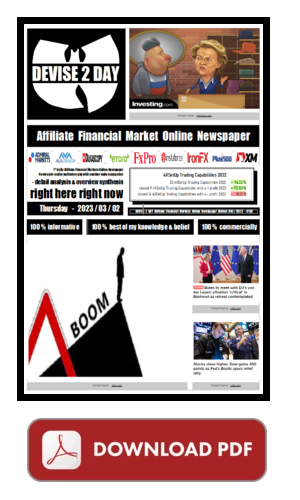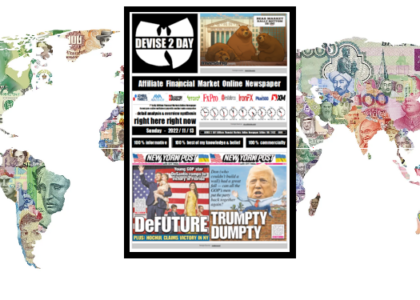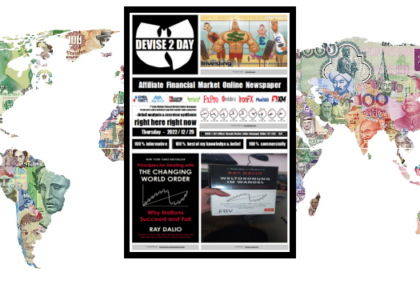
2023/03/02 (182.045) Technical Analysis – … & UKOIL
UKOIL Traded About 80 USD In February 2023
– After Lower Lows In January 2023 And/Or December 2022
How investors can benefit from a rising oil price
Analysts, oil traders and the International Energy Agency agree: the price of oil will rise. But investments in the black gold have their pitfalls.
The price of the world’s leading oil type, Brent, has been moving sideways for three months: the top price closed at EUR 90, and the price for a barrel (159 liters) has not fallen below the USD 75 mark. According to Commerzbank’s commodities experts, two issues are currently primarily determining the ups and downs on the oil market: the recovery in Chinese oil demand and Russia’s oil supply. In the opinion of the raw materials analyst Barbara Lambrecht, the indications that the supply shortfalls are limited have prevailed. This pushed the Brent oil price back to almost $80, especially as inventories in the US signaled ample supply to the market. But according to Lambrecht, there are harbingers that the Russian offer will soon be lower. Most recently, two Russian companies announced that they intend to reduce their exports in March, probably due to the low prices for Russian oil types.
Where is the next reason for bulls to expect the price to bounce back?
China’s zero-Covid policy is over. A recession in the US and Europe may not happen
– and Russia could soon be delivering significantly less oil worldwide. Is the next wave of inflation coming?
Just over a year ago, a barrel of Brent North Sea oil cost around 130 US dollars. First the prospect of war in Europe and then the actual Russian attack on Ukraine had caused the price to rise by 75 percent in two and a half months. In the run-up to the record lows at the height of the corona pandemic, things had gone uphill steeply. An oil price shock, especially for import-dependent Europe, which, in addition to the even more dramatic gas price shock, significantly drove up inflation rates. A year later, the good news is that this high also marked a turning point. Concerns about further price increases proved to be unfounded and at the end of last year a barrel of Brent was only worth around 80 US dollars. The low demand in China due to the zero-Covid policy, an impending recession in Europe and the USA – the latter also expanded production and released state reserves – provided relief. In addition, the feared slump in Russian oil exports did not materialize. And so the price trend showed downwards until the end of 2022 due to a slightly oversupplied market.However, that changed at the beginning of the new year. The price has been running sideways for two months now, moving between 80 and 85 US dollars. The downtrend appears to have stopped, which could herald a fresh price rally higher as some of the enumerated favorable factors are about to turn around.
More demand from China, less supply from Russia!
But does that compensate for the lower demand here in the so-called West during the stafglation?
More and more experts and/or oil traders consider USD 100 to be possible again! But we stay short under 90 USD…
Finally, the zero-Covid policy in China is history. The economic engine in the Middle Kingdom is not yet running at full speed, but that could change over the course of the year. OPEC therefore expects Chinese demand to increase by 500,000 barrels per day. In combination with a recession in the USA and Europe, which is now unlikely to happen after all, this could drive global hunger for oil more than expected. In addition, the import of Russian oil by sea was also banned in Europe at the beginning of February. It is unlikely that Russia can completely compensate for this via other markets. The International Energy Agency (IEA) therefore estimates that by the end of the first quarter of 2023, around one million barrels per day could be missing from Russia.
According to the Russian newspaper Kommersant, Russian crude oil production in February was actually two percent higher than in January, but a cut of 500,000 barrels per day has already been announced for March. The crucial question is whether this is short-term or whether it will be expanded, write the commodity experts at Société Generale. “Basically, we remain skeptical about the Russian supply and stick to our assessment that the situation on the oil market will tighten noticeably as Chinese demand continues to pick up,” the analysts continue. In addition, the latest developments in US drilling activities gave little hope that rising US production would compensate for Russia’s supply shortfalls. According to data from Baker Hughes, the recovery in US drilling activity has been stalled for several weeks. “In the meantime, the wells are even 4.2 percent lower than at the beginning of December,” according to the Société Generale experts.
It is only a matter of time before exports from Russia drop, agrees Carsten Fritsch, Commerzbank commodities analyst. In an interview with WirtschaftsWoche, he said: “Together with increasing global demand, this should push the price up. We expect the price of Brent oil to be around USD 95 per barrel in the middle of the year. By the end of the year, the price of oil could reach the $100 mark again.” This mark is also considered realistic among oil traders. The prospect of prices between $90 and $100 in the second half of the year is a real possibility, Vitol CEO Russell Hardy told Bloomberg. The latest estimates by the IEA fit in with this. The authority expects global demand to increase by 1.9 million to almost 102 million barrels per day in 2023. According to the IEA, the supply should also increase because the USA, Canada and possibly Brazil could produce more. However, the IEA only sees an increase of one million barrels per day here. A slightly oversupplied market could become a slightly undersupplied market by the second half of 2023 at the latest. Since the future is traded on the stock exchange, and here in particular in the raw materials sector, this could already be reflected in rising prices in the first half of the year.Let`s Get An Short Overview About The Price Action Of Some Commodities,
Because While Todays Trading Session Many Commodoties Traded Around Significant Areas
Rice Hits 10-week Low Canola Hits 7-week High Natural gas Hits 4-week High
Rice decreased to a 10-week low of 16.635 USD/cwt Canola to a 7-week high of 851 CAD/T Natural gas increased to a 4-week high of 2.79 USD/MMBtu
Cocoa Hits 26-month High Milk Hits 15-month Low Nuclear Energy Index Hits 7-week Low
Cocoa increased to a 26-month high of 2831 USD/T Milk ata 15-month low of 17.77 $/CWT Nuclear Energy Index at a 7-week low of 1461 USD
Rubber Hits 4-Week High
Rubber increased to a 4-week high of 141.7 USD Cents / Kg, as stronger-than-expected manufacturing activity growth by top buyer China buoyed demand sentiment. On the supply side, the International Rubber Consortium indicated that natural rubber production is expected to go down by the major producing countries due to the spread of leaf disease, erratic weather conditions, rising climate temperatures, and low fertilizer input caused by higher costs. Meanwhile, Toyota Motor Corp boosted global vehicle production by 9% in January, marking its first increase in three months, but still falling short of its plan due to COVID-related parts shortages.
Palm Oil Hits 8-week High
Palm Oil Hits 8-week High Malaysian palm oil futures were trading around the MYR 4,300 per tonne mark, closing in on their highest level since November 2022, buoyed by brisk export demand, a weaker ringgit, and supply concerns. Exports of Malaysian palm oil products for Feb. 1-25 rose between 15.3% and 25.4% from the same period in January, cargo surveyors showed. On top of that, the Malaysian Meteorological Department warned of danger-level continuous rain across western regions, raising flooding risks and sparking concerns about disrupted supplies. Supporting prices further, key markets India and China might need to refill their inventories of edible oil in the coming months. At the same time, any unfavorable weather conditions in India could ignite worries about the country’s domestic production.
Gold Eases on Rate Hike Concerns
Gold eased toward $1,830 an ounce on Thursday, snapping a three-day advance as investors continued to fret about the prospect of further monetary tightening from major central banks. In the US, Atlanta Fed President Raphael Bostic called for continued rate hikes to above 5% to make sure inflation does not pick up again, while Minneapolis Fed President Neel Kashkari said the central bank’s rate hikes are not having much of an impact on the services sector. Data on Wednesday also showed that German consumer prices increased more than expected in February, bolstering the case for further policy tightening from the European Central Bank. Gold is highly sensitive to the rates outlook as higher interest rates as higher interest rates raise the opportunity cost of holding non-yielding bullion and vice versa.
Brent Steadies Tiday As Traders Mull Outlook
While Baltic Exchange Dry Index Rises To Over 7-Week High
Brent crude futures steadied above $84 per barrel on Thursday as investors weighed hopes for a rebound in Chinese demand against concerns about further policy tightening from the Federal Reserve. Oil prices gained nearly 1% on Wednesday after data pointed to robust manufacturing and services activities in China, and top executives from Chevron Corp and Saudi Aramco signaled optimism for the country’s demand. Meanwhile, Atlanta Fed President Raphael Bostic called for continued rate hikes to above 5% to ensure inflation does not pick up again.
The Baltic Exchange’s main sea freight index, which measures the cost of shipping goods worldwide, was up for the ninth straight session on Wednesday, surging about 11% to its highest since January 10th at 1,099 points, amid firmer demand across all vessel segments. “The dry bulk market looked optimistic in the short term on an expected increase in Chinese iron ore demand if construction activity recovers, and seasonal Brazilian exports,” said Yiannis Parganas, head of Intermodal Research Department. The capesize index, which tracks iron ore and coal cargos of 150,000 tonnes, was up for an eighth successive day, jumping 27.4% to 929 points; and the panamax index, which tracks coal or grain cargoes of about 60,000 tonnes to 70,000 tonnes, was up for the seventh straight session, rising 6.6% to a near 10-week high of 1,515 points. Among smaller vessels, the supramax index added 51 points at 1,156 points.
good morning, good day, and/or good night
at whatever time, wherever you are !
right here right now :


















